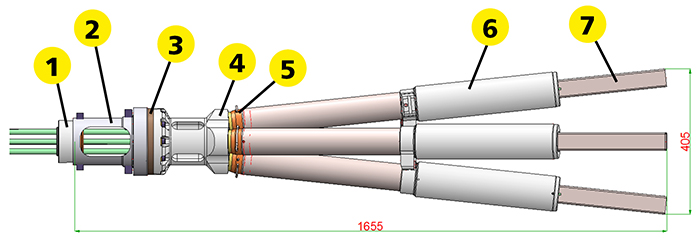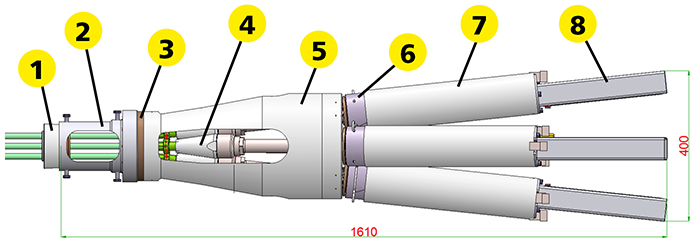 Version 1: Anchor plate at the structure end for e.g. four strands (1), wedge-seating plate with barrel (2), deflection plate (3), support seat for four strands (4), quick coupling (5), four TENSA SM 240 kN stressing jacks (6) and anti-twist protection with integrated ruler (7). As an option one can use a wedge-seating cylinder between (2) and (3).
Version 1: Anchor plate at the structure end for e.g. four strands (1), wedge-seating plate with barrel (2), deflection plate (3), support seat for four strands (4), quick coupling (5), four TENSA SM 240 kN stressing jacks (6) and anti-twist protection with integrated ruler (7). As an option one can use a wedge-seating cylinder between (2) and (3).
Stepped anchors are a special form of compression anchors. Both types are used as ground anchors in various fields, for example when it comes to stressing walls or tunnel slabs against the soil. They are differing in that the individual strands of a stepped anchor do not have the same, but different lengths. The load transmission range of the individual strands is staggered in succession in the soil, which ensures a more uniform load transmission into the subsoil. Stepped anchors are used if the soil is not sufficiently load-bearing for a standard compression anchor.
In practice, stepped anchors are often stressed using single-wire stressing jacks, thus ensuring the same stressing force in the individual strands. The disadvantages of alternative methods using multi-strand stressing jacks are: different stresses, the need to thread the strands at the same time and the time-consuming adaptation of the jack to different anchor types.
Paul Maschinenfabrik, experts for prestressed concrete technology, have already successfully made experiences with stepped stressing jacks in the past, have optimized the method and are now offering two versions of stepped stressing jacks. Both versions are using a special support seat with stressing jacks that are individually applied and hydraulically connected. This method offers the following advantages:
Version 1
Version 1 is made up of a special support seat and is used with stressing jacks type TENSA SM 240 kN which have proven for many years. This version has already been used in the past, has now been optimized and offers the following advantages:
Version 2
Version 2 uses stressing jacks specifically optimized for this purpose. These jacks are fitted with an exterior stressing grip. It is thus possible for the stressing grip to move closer to the anchor plate at the structure end. The necessary strand projection is thus reduced by 30%. The advantages are:

